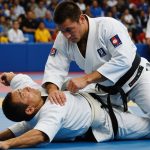Importance of Fielding Agility in Cricket
The role of agility in successful fielding cannot be overstated. In the high-stakes world of cricket, players with exceptional fielding agility consistently become game-changers. Agility empowers fielders to react swiftly, allowing them to catch balls efficiently and save runs, enhancing their team’s overall performance.
Fielding agility significantly impacts overall team performance. Agile fielders can cover more ground quickly, creating opportunities to secure outs that might otherwise be missed. This ability to deliver quick, precise actions transforms defensive strategies and offers the team a broader tactical advantage, often shifting the match’s course.
Also to discover : Thriving under pressure: essential focus techniques for dressage competitors
Furthermore, agility fundamentally influences game strategy. Coaches often design their strategies based on fielders’ agility, strategically placing agile players in key positions. For instance, agile players are more frequently positioned in the inner circle, where rapid responses are crucial.
To improve fielding efficiency, players can engage in specific drills and exercises designed to enhance agility. Including these in regular practice sessions fosters not only personal skill improvement but also contributes to a successful team dynamic. Thus, refining fielding agility is a path to elevating cricket performance.
Have you seen this : Mastering grip strength: key techniques for judo athletes to elevate performance
Expert Strategies for Enhancing Agility
Gaining expertise in cricket requires more than just talent; it demands precise skills and agility enhancement. Focused training in this area is crucial for both budding and seasoned players.
Dynamic Drills for Improved Agility
Dynamic drills are key in boosting a player’s agility. Incorporating exercises like ladder drills, cone drills, and reaction ball exercises can significantly improve fielding speed and maneuverability. By regularly practicing these drills, players can enhance their reaction time, making it easier to perform under pressure.
Importance of Core Strength and Flexibility
Core strength and flexibility are foundational to agility in cricket. Engaging in a routine that involves yoga or Pilates can help maintain the flexibility essential for quick, responsive movements on the field. A strong core stabilizes the body, allowing for smoother transitions and more efficient movements.
Techniques for Quick Decision-Making on the Field
Rapid decision-making underpins successful cricket strategy. Players should engage in scenario-based training, where they simulate match conditions to improve this skill. Cognitive exercises, like quick-response drills and concentration games, can also enhance a player’s ability to make split-second decisions. Developing these skills contributes to higher precision and better execution during the game.
Specific Drills for Practicing Fielding Skills
Fielding drills are crucial for enhancing a cricketer’s agility and overall skill development. Properly structured practice routines can make a significant difference in a player’s performance on the field. Here’s a walkthrough of some agility drills specifically designed for cricketers:
Overview of Agility Drills
Agility drills are targeted exercises that aim to improve a player’s speed, coordination, and reaction time. They mimic on-field scenarios, allowing players to apply skills effectively during matches.
Step-by-Step Guide
To execute an agility drill like the ‘Sprint and Catch’:
- Sprint Phase: Mark a distance of 20 meters. Sprint from one end to the other with maximum speed.
- Catch Phase: At the end of the sprint, a coach or fellow player throws a ball, requiring the player to perform a quick catch.
- Return: After catching, quickly return the ball to the thrower and jog back to the starting position.
Repeat this cycle to build reaction time and hand-eye coordination.
Integration Into Practice Routines
To maximise benefits:
- Implement these drills at the start of each practice session for warming up.
- Tailor the intensity based on individual or team requirements to ensure consistent improvement.
By including these fielding drills in routine practices, players can significantly enhance their on-field performance.
Body Positioning for Optimal Fielding
When it comes to mastering fielding techniques, the importance of body positioning cannot be overstated. Ensuring that one is optimally positioned significantly enhances a player’s ability to field effectively.
Key Stances for Fielding Various Types of Deliveries
Fielders must be versatile in their stances to handle different deliveries. Key stances include the relaxed stance for grounders, where knees are bent slightly, and the body weight is balanced on the balls of the feet. For high catches, a higher stance with eyes fixed on the ball ensures better catching probability.
Maintaining Balance and Readiness
Balance is crucial in adopting efficient fielding techniques. Fielders should maintain a low center of gravity with feet shoulder-width apart, enabling quick movement in any direction. Staying on the balls of one’s feet aids readiness, promoting immediate response to unpredictable ball movements.
Adjusting Positioning Based on the Batsman’s Shot
Defensive strategies require constant adjustment of positioning based on the batsman’s shot. For power hitters, a slightly deeper position helps intercept long deliveries. Conversely, for players exhibiting softer shots, fielders should advance closer to cut angles and prevent easy runs. Understanding these nuances allows fielders to apply strategic positioning effectively.
Mental Preparation and Focus
In cricket, mental preparation is vital for effective fielding. Fielders need mental agility to respond quickly and make split-second decisions. Developing a performance mindset helps players stay calm under pressure and maintain high alertness.
Focus techniques play a crucial role in a fielder’s ability to stay engaged throughout the match. One strategy involves setting small, achievable goals for each play. This can help maintain concentration and boost confidence over time. In addition, staying in the moment and avoiding distractions can significantly improve performance.
Visualization strategies are also beneficial, as they allow players to mentally rehearse potential game scenarios. This practice helps players anticipate plays and feel more prepared when facing similar situations on the field. Visualization not only enhances performance by familiarising players with different scenarios but also fosters confidence.
Furthermore, practicing breath control is a helpful technique to centre the mind and reduce anxiety. By focusing on controlled breathing, players can ground themselves and sustain their concentration during the game.
Embracing these techniques fosters a robust mental preparedness, allowing fielders to maximise their potential and contribute effectively to their team’s success. By honing these skills, players can strengthen their mental focus, leading to consistent and impressive fielding performances.
Testimonials and Success Stories
Player testimonials reveal profound stories of transformation and progress in the domain of baseball, accentuating the true power of agility training. Take, for instance, Jake’s remarkable journey. Initially struggling with his outfield performance, Jake incorporated agility drills into his regimen. His narrative is a success story of perseverance and dedication leading to exceptional fielding improvement.
One particularly impactful approach was his focus on lateral movements and quick footwork. Jake explains, “Incorporating these drills daily allowed me to react faster and stay balanced during unexpected plays.” Such testimonials not only convey personal triumphs but also shed light on specific strategies that effectively bridge gaps in performance.
The statistical improvements are significant. Post training, Jake’s fielding percentage increased by 15%, a testament to the power of agility-focused practice. His story is echoed by others, with many sharing significant upticks in both personal confidence and team contribution.
Players consistently report the monumental impact that agility can have on game dynamics, further inspiring others to embrace these transformative exercises. These tangible results and heartfelt accounts exemplify how agility training shapes careers and enriches the spirit of baseball.
Relevant Statistics and Coaching Insights
Performance in sports relies heavily on understanding agility and its impact on fielding capabilities. Agility statistics reveal that players who excel in swift lateral movements often have superior fielding metrics. Such statistics are vital in coaching recommendations for individual improvements.
Key Statistics on Agility
Understanding agility metrics is crucial for athletes and coaches aiming to optimize performance. High fielding metrics not only enhance gameplay but also mark players as assets in defensive positions. Precisely measured, these statistics highlight strengths and areas for development, invaluable in shaping effective training regimes.
Expert Coaching Insights
Experts in coaching provide insights into enhancing fielding techniques tailored to an athlete’s specific agility levels. Key recommendations include drills that simulate real-game scenarios, focusing on both speed and precision. Personalized coaching recommendations can enhance players’ performance by integrating agility-specific drills into regular training.
Personalized Training Plans
Implementing player statistics into training plans allows athletes to focus on individual weaknesses. Transformative coaching recommends creating personal training regimes that align with performance statistics. This targeted approach assists players in reaching optimal fielding capabilities, ensuring that every training session contributes effectively to personal and team goals.











